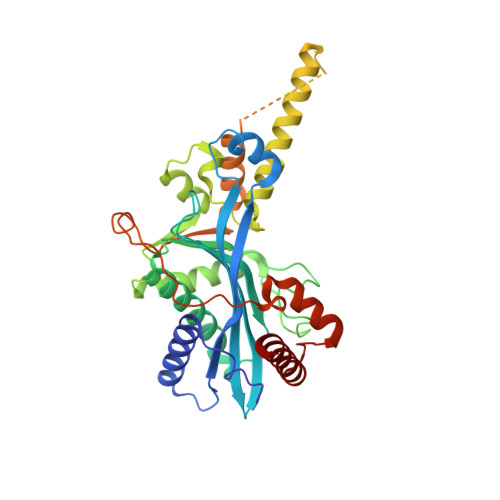Structure of the p300 Histone Acetyltransferase Bound to Acetyl-Coenzyme A and Its Analogues.
Maksimoska, J., Segura-Pena, D., Cole, P.A., Marmorstein, R.(2014) Biochemistry 53: 3415-3422
- PubMed: 24819397
- DOI: https://doi.org/10.1021/bi500380f
- Primary Citation of Related Structures:
4PZR, 4PZS, 4PZT - PubMed Abstract:
The p300 and CBP transcriptional coactivator paralogs (p300/CBP) regulate a variety of different cellular pathways, in part, by acetylating histones and more than 70 non-histone protein substrates. Mutation, chromosomal translocation, or other aberrant activities of p300/CBP are linked to many different diseases, including cancer. Because of its pleiotropic biological roles and connection to disease, it is important to understand the mechanism of acetyl transfer by p300/CBP, in part so that inhibitors can be more rationally developed. Toward this goal, a structure of p300 bound to a Lys-CoA bisubstrate HAT inhibitor has been previously elucidated, and the enzyme's catalytic mechanism has been investigated. Nonetheless, many questions underlying p300/CBP structure and mechanism remain. Here, we report a structural characterization of different reaction states in the p300 activity cycle. We present the structures of p300 in complex with an acetyl-CoA substrate, a CoA product, and an acetonyl-CoA inhibitor. A comparison of these structures with the previously reported p300/Lys-CoA complex demonstrates that the conformation of the enzyme active site depends on the interaction of the enzyme with the cofactor, and is not apparently influenced by protein substrate lysine binding. The p300/CoA crystals also contain two poly(ethylene glycol) moieties bound proximal to the cofactor binding site, implicating the path of protein substrate association. The structure of the p300/acetonyl-CoA complex explains the inhibitory and tight binding properties of the acetonyl-CoA toward p300. Together, these studies provide new insights into the molecular basis of acetylation by p300 and have implications for the rational development of new small molecule p300 inhibitors.
Organizational Affiliation:
Program in Gene Expression and Regulation, The Wistar Institute , 3601 Spruce Street, Philadelphia, Pennsylvania 19104, United States.
















